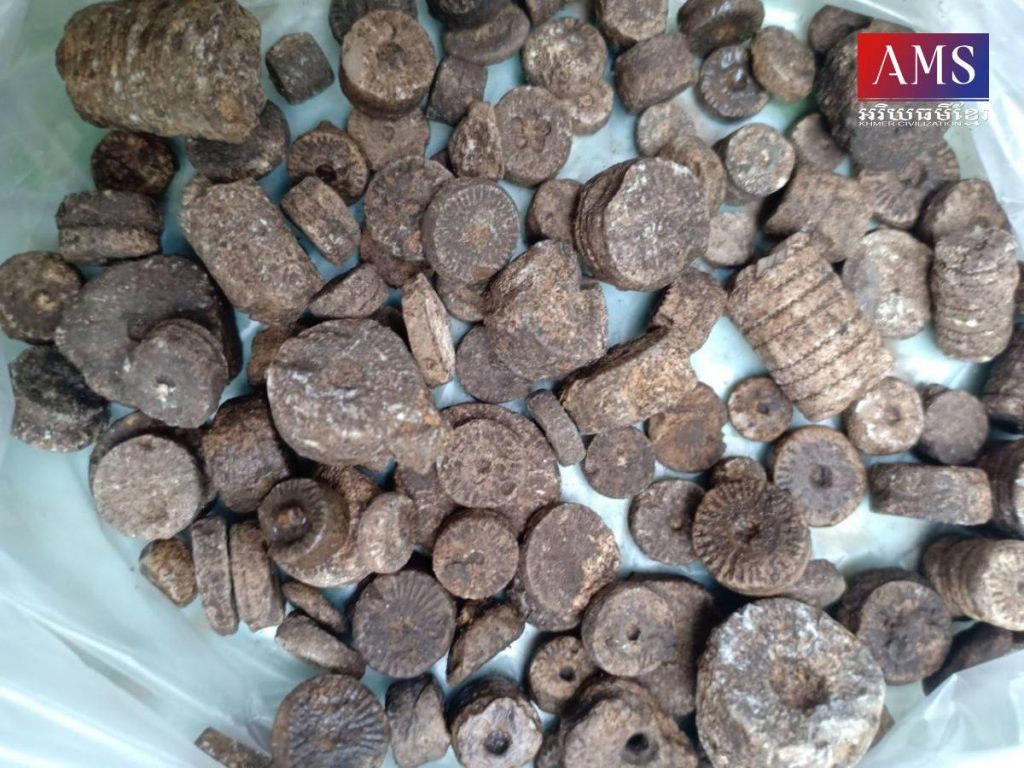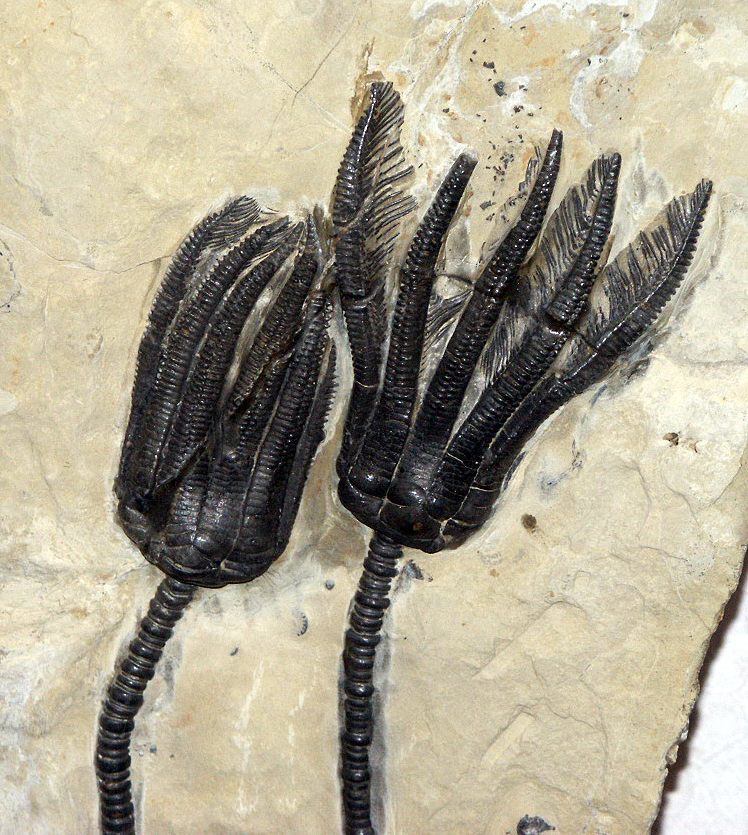ចាប់ពីឆ្នាំ២០១៩មក ក្រុមការងារសិក្សាស្រាវជ្រាវផូស៊ីល ដោយនាយកដ្ឋានតំបន់បេតិកភណ្ឌ អគ្គនាយកដ្ឋានសហគមន៍មូលដ្ឋាន នៃក្រសួងបរិស្ថាន បានចាប់ផ្តើមធ្វើការសិក្សាស្រាវជ្រាវអំពីជីវចម្រុះសម័យបុរាណ នៃប្រទេសកម្ពុជា។ មកដល់ពេលនេះយើងបានចុះសិក្សាព័ត៌មានបឋម បានចំនួន២៤ទីតាំងមកហើយ និងធ្លាប់បានចុះផ្សាយក្នុងប្រព័ន្ធវេបសាយ AMS អរិយធម៌ខ្មែរ ជាបន្តបន្ទាប់ អំពីទីតាំងមួយចំនួនដែលបានសិក្សាផងដែរ។ ក្នុងអត្ថបទនេះ ខ្ញុំនឹងលើកយកពីប្រភេទសត្វមួយក្រុមដែលហៅថាគ្រីណូអុីត Crinoids ។ ពាក្យស័ព្ទមួយចំនួន គឺពិបាកនឹងរកពាក្យជាភាសាខ្មែរមកប្រើប្រាស់ ពេលខ្លះយើងយកភាសាបរទេសមកសរសេរជាខ្មែរ ហើយក៏នឹងអាចមានការលំអៀងនៃការប្រើប្រាស់ពាក្យដោយអន្លើណាមួយជាពុំខាន។
គ្រីណូអុីតជាអ្វី? Crinoids គឺជាសត្វសមុទ្រមួយក្រុមដែលបង្កើតជាក្រុម Crinoidea ដែលជាផ្នែកមួយនៃ Phylum Echinodermata ដែលរួមបញ្ចូលទាំងក្រុមផ្កាយសមុទ្រ (Starfish), ក្រុមនេះក៏រូបរាងប្រហាក់ប្រហែលផ្កាយសមុទ្រ(Brittle Stars)ដែរ, ក្រុមកាំប្រមាសមុទ្រ (Sea Urchins) និង ក្រុមឈ្លើងសមុទ្រ (Sea Cucumbers)។
គ្រីណូអុីត បានបន្តមករស់នៅរហូតដល់ពេលបច្ចុប្បន្នដែលមានប្រមាណជា៥៤០ពូជ។ សម្រាប់ក្នុងប្រទេសកម្ពុជា ខ្ញុំក៏មិនដឹងថាតើមានឬយ៉ាងណា? តែខ្ញុំយល់ថាគួរតែមាន ដោយយើងខ្វះឯកសារពីប្រទេសយើង។ តាមរយៈឯកសារមួយ គឺបានបង្ហាញពីប្រភេទក្រុមសត្វដែលនៅជិតស្និតនឹងក្រុមសត្វគ្រីណូអ៊ីត ដូចជាពពួកផ្កាយសមុទ្រ កាំប្រមាសមុទ្រ និងក្រុមឈ្លើងសមុទ្រដែលមានក្នុងប្រទេសកម្ពុជា។
ប្រវត្តិនៃការរកឃើញសំណាកផូស៊ីលគ្រីណូអុីតខ្លះ ត្រូវបានគេហៅថាផ្កាលីលីសមុទ្រ។ ផូស៊ីលគ្រីណូអុីតត្រូវបានរកឃើញ មានជីវិតនៅលើផែនដីកាលពីប្រមាណ៤៥០លានឆ្នាំមុន។ សត្វគ្រីណូអុីត មានរូបរាងដូចជាផ្កាព្រលិតមួយដើមដែលមានផ្នែកផ្កា ដើម និងឫស ខ្លះមានដើមខ្លី និងខ្លះមានដើមវែង។ គេបានរកឃើញគ្រីណូអុីតខ្លះមានប្រវែងដល់ទៅ១ម៉ែត្រ។ ពួកវាជាប្រភេទសត្វដែលរស់នៅក្នុងទឹករាក់។ ថ្វីត្បិតយើងមើលទៅហាក់ដូចជារុក្ខជាតិតែការពិតពួកគ្រីណូអុីត ជាសត្វអាចធ្វើដំណើរ និងហែលទឹកបាន។
នៅក្នុងប្រទេសកម្ពុជាយើងបានជួបប្រទះផូស៊ីលសត្វគ្រីណូអុីត ដែលមានផ្នែកខាងក្បាលរបស់វានៅភ្នំស្វាយ ក្នុងខេត្តបន្ទាយមានជ័យ។ ភ្នំស្វាយជាប្រភេទភ្នំថ្មកំបោរដែលមានអាយុកាលនៅស័កទី១ ក្នុងសម័យ Permian (២៥១-២៩៩លានឆ្នាំ)
ភ្នំស្វាយ ជាស្ថានីយមួយដែលយើងបានរកឃើញផូស៊ីលពពួកសត្វគ្រីណូអីុតច្រើនគេ។ តែភាគច្រើនរកឃើញតែបំណែកដើមរបស់ពួកវាតែប៉ុណ្ណោះ។ ពួកវាប្រហែលស្ថិតនៅក្នុងថ្ម តែយើងពុំទាន់បានសិក្សាបានលម្អិតអំពីទីតាំងនីមួយនៅឡើយ។ តាមរយៈផ្នែកដើមនៃគ្រីណូអុីត (Crinoid columnal) មានលក្ខណៈមិនដូចគ្នានោះទេ និងអាចបែងចែកជាប្រភេទផ្សេងៗ។ យើងប្រទះឃើញប្រមាណ៥ប្រភេទ ឬច្រើនជាងនោះ ដោយយើងសំគាល់ទៅលើស្នាមរន្ធនៅកណ្តាល ស្នាមឆ្នូតៗនៅជុំវិញរន្ធនោះ និងទំហំនៃដើមរបស់វា សូមមើលរូបដែលថតពីភ្នំស្វាយ និងគំរូខ្លះៗនៃប្រភេទគ្រីណូអុីត។
ពពួកផូស៊ីលសត្វគ្រីណូអុីតត្រូវបានយើងរកឃើញ នៅតាមស្ថានីយផូស៊ីលមួយចំនួនក្នុងប្រទេសកម្ពុចាដូចជា ខេត្តបន្ទាយមានជ័យ រកឃើញច្រើនជាងគេ ភ្នំស្វាយ(ច្រើន) ភ្នំជញ្ជាំង(ច្រើន) ភ្នំបាក់(មធ្យម) ភ្នំដូងព្រះ(តិច) ភ្នំកងវ៉ា(តិច) ភ្នំព្រះភ្នំវែង(មធ្យម)។ ខេត្តបាត់ដំបង ភ្នំសំពៅ(តិច) ភ្នំបាណន់(តិច) ភ្នំគោហា(តិច)។ ខេត្តស្ទឹងត្រែង រកឃើញនៅថ្មកំបោរ តំបន់រាមសារទន្លេមេគង្គ (តិច) ភ្នំឈ្ងោក(តិច) ភ្នំចាបភ្លើង ក្នុងស្រុកថាឡាបរិវាត់។ ខេត្តកំពត ភ្នំកំពង់ត្រាច (តិច) ដែលរកឃើញក្នុងរូបភ្នំ និងអាចមាននៅទីតាំងផ្សេងៗទៀតដែលយើងមិនទាន់មានទិន្នន័យនៅឡើយ។
រួមសេចក្តីមកតាមរយៈផូស៊ីលសត្វគ្រីណូអុីត ដែលរកឃើញនៅក្នុងប្រទេសកម្ពុជា នេះត្រូវបានកំណត់អាយុកាលក្នុងស័កទី១ក្នុងសម័យ Permian (២៥១-២៩៩លានឆ្នាំ)។ នោះមានន័យថានាស័កទី១ ប្រទេសកម្ពុជាស្ទើរតែទាំងស្រុងស្ថិតនៅក្រោមសមុទ្រនៅឡើយ។ យើងសង្ឃឹមថានឹងមានអ្នកជំនាញខាងផូស៊ីល ដើម្បីសហការចូលរួមធ្វើការស្រាវជ្រាវឱ្យកាន់តែលម្អិតអំពីពពួកផូស៊ីលនីមួយៗ ដែលក្រុមការងារបានរកឃើញនៅតាមបណ្តាស្ថានីយមួយចំនួនក្នុងប្រទេសកម្ពុជា។
—————————————————-
Ancient marine animals species “Crinoids” million years in Cambodia
From 2019, the Fossil Research Team by the Department of Heritage, General Department of Local Communities of the Ministry of Environment has started A study of the ancient biodiversity of Cambodia. So far, we have studied 24 sites as preliminary information and have also studied some of the fossils sites in Cambodia which published on the AMS Khmer Civilization website. In this article, I will mention a group of species called Crinoids.
Crinoids are marine animals that make up the class Crinoidea, one of the classes of the phylum Echinodermata, which also includes the starfish, brittle stars, sea urchins, and sea cucumbers. Crinoids have survived to the present day, numbering about 540 species. I also do not know if there is or not in Cambodia? But I think it should be because we lack documents from our country. According to a document, a group of species close to the group of Crinoids, such as sea stars, sea urchins, and sea cucumber in Cambodia.
The history of discovery fossils is called sea lilies. Crinoids fossils were discovered to have lived on Earth about 450 million years ago. The Crinoids are shaped like a lotus flower, with some of the stems short or long and roots. Some Crinoids up to 1 meter long were found. They are species that live in shallow water. Although it was looked like plants, they are actually animals that can travel and swim.
In Cambodia, we encountered a Crinoids fossil at Phnom Svay in Banteay Meanchey province. Phnom Svay is a sort of limestone mountain that dates back to the first era in the Permian period (251-299 million years).
Phnom Svay is one of the sites where we found most of the Crinoid fossils, but most found only their original fragments. They probably are in the rocks, but we have not yet studied the details of each site. Through the original Colinoids (Crinoid columnal) are not the same and can be classified into different types. We find about five or more species, noting the notch in the center and the notch around the hole.
Crinoid fossils have been found at a number of fossils sites in Cambodia namely Banteay Meanchey (Phnom Svay, Phnom Chonhcheang, Phnom Bak, Phnom Doung Preah, Phnom Kang Va, Phnom Preah, and Phnom Long), Battambang Province (Phnom Sampov, Phnom Banan, Phnom Kok Ha), Stung Treng Province Found in the limestone area of Ramsar, Mekong River (Phnom Chhnok, Phnom Chap Phleung in Thala Borivat District), Kampot province, Phnom Kampong Trach found in the mountains and maybe in other places where we do not have data Meaning yet.
In conclusion, fossils found in Cambodia have been identified in the first era in the Permian period (251-299 million years). It means that in the first era, Cambodia is almost completely under the sea. We hope to have fossil experts collaborate on more detailed further research on each of the fossils found by the team at a number of sites in Cambodia.
អត្ថបទដើម៖ លោក លឹម វណ្ណច័ន្ទ








